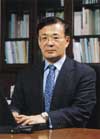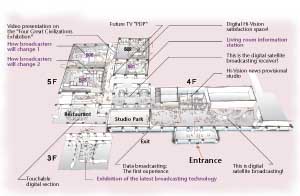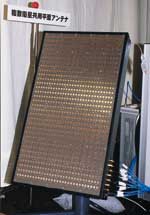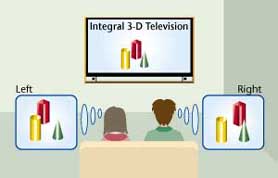|
 First
Presentation of Our Research Results at Broadcasting
Center First
Presentation of Our Research Results at Broadcasting
Center
By
Osamu YAMADA,
Director-General,
NHK Science & Technical
Research Laboratories
This year's annual open
house of our laboratories
will be held jointly with
the BS Digital Fair at
the Broadcasting Center
in Shibuya. Here I will
introduce selected items
from the main exhibitions.
Studio 501 will feature
a provisional "future
living room." This exhibition
will highlight the various
influences and changes
that television will bring
about in peoples' lives.
The home server that we
are developing as a new
home program storage device
for the digital era offers
numerous new and convenient
TV viewing styles.
In Studios 506 and 505,
we will present "human-friendly
broadcasting technology"
and "fascinating program
technology" based on the
theme of "How broadcasters
will change." Studies
on "human-friendly broadcasting
technology" are underway
for providing broadcasting
services. One product
of this research is a
broadcast news transcription
system that automatically
recognizes a studio announcer's
speech and instantly creates
subtitles in proper Japanese
using Kanji and Kana.
The "fascinating program
technology" section will
offer a glimpse of efficient
program production technology
that makes optimum use
of computer technology.
These exhibitions include
new virtual studio and
intelligent robotics.
Exhibited in the 3rd floor
and Tent 2000 will be
the latest broadcasting
technology developed by
NHK. The exhibition will
contain a 3-D television
for future broadcasting
services and a multi-beam
receiving flat antenna
for satellite broadcasting.
These colorful research items will be exhibited
to plainly introduce our viewers to the coming
digital satellite broadcasting systems.
Please look forward to the event and visit
the sites.
| BS
Digital Fair Event
Map |
 |
| BS
Digital Fair Main
Exhibitions |
Studio
501
Living room information station
Contents: By establishing a provisional "future
living room" in the studio, we will introduce the various
influences and changes that television will bring about in
peoples' lives.
Exhibited items: Home
server,etc.
|
 |
Studio
505
How broadcasters will change (2)
Contents: On the theme of "Omoshiro (fascinating)
program technology," television cameras and special audio/video
technology materials are presented.
Exhibited items: Ultrahigh-sensitive
HDTV handheld camera, Ultraviolet sensitive color TV camera,
Hi-Vision high-speed camera system, Intelligent robotics,
TVML, Insect microphone, etc.
| Ultrahigh-sensitive
HDTV handheld camera |
 |
A powerful tool in the production of night-time scientific
programs and emergency news.
- A camera that can capture clear color images even
when utilizing star light. (100 times more sensitive
than an ordinary camera)
- A powerful tool for scientific programs featuring
auroras, total solar eclipses, nocturnal animals, deep
sea photography, and for emergency reports, etc.
- The first appearance of a new compact HDTV handheld
camera. |
3rd floor
Exhibition of the latest broadcasting
technology
Contents: The latest broadcasting
technology products resulting from NHK's research and development
activities.
Exhibited items: Integral
3-D Television that does not require special glasses, Axi-vision
camera, Multi-beam receiving flat antenna for satellite broadcasting,
etc.
| Multi-beam receiving
flat antenna for satellite broadcasting |
 Simultaneous
reception of broadcasts from multiple satellites. Simultaneous
reception of broadcasts from multiple satellites.
Flat antennas comprise many small antenna elements.
The radio waves received by the antenna elements are
then electronically combined, allowing the flat antenna
to simultaneously receive broadcasts from a large number
of satellites. |
|
 |
Studio
506
How broadcasters will change (1)
Contents: A variety of
barrier-free technologies are introduced based on the theme
of "human-friendly broadcasting technology."
Exhibited items: Broadcast
news transcription system, User-friendly remote controller,
Speech rate converter, Braille broadcasting receiver, etc.
| Broadcast news transcription
system |
 |
It provides closed-captioning for TV news programs.
- The system automatically creates subtitles of the
announcer's voice during live broadcasts.
- Recognition accuracy reaches up to 95% when the main
newscaster reads a manuscript in the studio. |
|
 |
Tent
2000
| Integral
3-D Television |
 |
An eye-position-insensitive 3-D TV display with no
special glasses
1) No need for special glasses.
2) Different views can be seen depending on the viewer's
movement.
3) Even lying down, the viewer can see proper 3D images.
|
|
|
|

